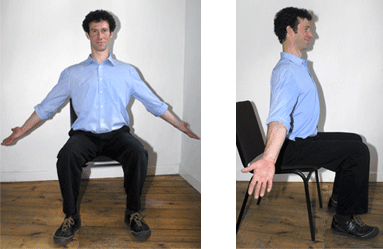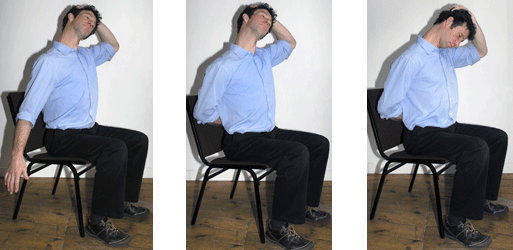Spinecare
- Andy Scott

- Mar 19, 2020
- 6 min read
Motion is Lotion!
Motion is Lotion! Walking would be the best advice I could give for around 90% of spinal issues. Sometimes pain or dysfunction gets in the way and we need to step down the challenge a little to start with…

Find your baseline – somewhere you can start from which doesn’t push you too hard – I love the ‘3/10 for effort’ approach here. It’s achievable, your mind is saying, “Yes, I can do that – sure…” Wherever you are, you know you can go back to that and not be struggling too much… We all need a safe place when times get hard, but we do need to move. Read the ‘breath and relaxation’ section in Chronic Conditions.
Comfort Positions
This is all about getting the spine into a fairly neutral, unloaded position where it is not painful. This is important as it gives struggling, painful structures a window of rest. Combine this with long slow belly breaths, positive feedback for your sensory system – music, mellow light, favourite smells, positive mental imagery: favourite places, moments where you felt nurtured, supported. You are trying to foster a ‘therapeutic sigh’ where things don’t feel quite so bad anymore…
These are a few positions that often work, depending on your body type and what’s causing your pain. We’re pretty good at finding these instinctively but if in doubt, experiment. If you struggle getting to the floor, make a nest in your bed or have a chair nearby to help you down and back up. Try different sized pillows, cushions, beanbags are great! You may need to keep shifting between them if you’re trying to sleep as inactivity makes us stiffer and sustained postures can start to overload structures. It’s why sitting in a chair all day is not that great for us…

Supine
Plenty of support under the legs, this allows the back to flatten. Sometimes people like a small cushion in the small of the back to keep a little extension in there.Notice the green ball under my head – these are called ‘overballs,’ they are awesome for grumbly necks, small ball generally around 20cm. They come flat, just blow a little air into them so your head feels well supported. You can do gentle nods, as in the ‘chin tuck’ further down this page, draw little circles with your nose, whatever feels good…

Prone
Good if you have difficulty putting pressure on the back or have pain down the back of a leg… If you prop yourself up enough, pillows under elbows, keep the back of the neck fairly long, you can get away with using a computer or watching telly for a while like this! Try wagging your tail or pushing up through an arm out to the side to rotate a little – I have gained expert level with this one!

Side Lying
Can be good if you have pain radiating down a buttock and/or leg – make sure it’s the one on top. This can be good for painful knees and hips too. Depending on your build, you might find it useful to have a rolled towel or thin pillow in the small of the waist to limit the spine sagging. Head supported into neutral. Can pretty much make this into the ‘recovery position’ and sleep like this…
Neck and Trunk Exercises

The neck and trunk exercises could be of use to anyone who sits at a desk as part of their daily work. They are quick and easy, and don’t have to get in the way of work. Try getting into a routine of doing some throughout the day, current recommendations suggest hourly exercises, ideally getting up for a quick walk too. For those experiencing neck pain, you actually might find it useful to do them more often than this. Get up from the chair regularly, even if it's just for a moment, break the patterns of sustained loading... The lying exercises are great for easing acute back pain and getting some easy movement started. As your back settles try to keep moving as much as possible, exercises here will concentrate on regaining full movement and building core strength to support the back. Regular walking will generally help with this too. Find what you can comfortably manage without flaring up your pain and then try to gradually build on this.
Figure 1 shows what happens to the spine as gravity starts to take control in prolonged sitting, putting tension into the whole back and neck. Figure 2 shows that if we sit tall; tucking the chin in, lifting the breastbone and rolling our pelvis forwards slightly, we take the strain out of the system.
The Brugger relief position
This stretch was designed to counteract some of the strains produced by working at a desk. Sit tall as in Figure 2, lifting the breastbone and tucking the chin in. Knees should be wider than hips. Roll shoulders down and back, stretch the arms out to the sides and spread the fingers wide, trying to point the thumbs backwards. Breathe in deep to the belly, let it go with a big sigh for three or four long cycles. Feels good right? Perfect for that stressful moment - find that breath more often...

Basic shoulder rolling
With a tall spine, roll the shoulders up towards your ears, then round and back to stretch across the chest and the top of the shoulders. (It’s natural to hear a few clicks and crunches here!) Repeat a few times.

Pelvic clock in sitting
Imagine your pelvis as a bowl with a ball in the centre of it – on its inside is the face of a clock. As you soften your back, dip your breastbone and roll the pelvis backwards, the ball rolls up to the 12 o’clock position. Now lift the breastbone and roll the pelvis forwards to slightly arch the back, the ball rolls to the 6 o’clock position. Find a balance between these two movements – this is the spine’s neutral position. Keeping the chest lifted now try and move the ball between the 3 and 9 o’clock positions by making the weight shift between either buttock. For a further stretch, keep extending through your trunk muscles to lift alternate shoulders. Get playful, change directions, coordinate your breaths with the movement, try some long sighing outbreaths...

Chin tucks
Great for mobilising stiff necks! Sit tall, breastbone lifted and shoulders pulled down and back. Look at something at eye-level to keep your head level, tuck your chin in and draw your head backwards to feel a light stretch at the back of the neck and then release again. Do this three times and then leave it for a bit. If you find it difficult to feel the movement, try it standing with your back to a wall to stabilise your shoulders, a car seat with a head rest will do the same thing. Lie down and try this with your head resting on an over ball blown up so your head feel comfortably supported - just gentle nods, draw little circles with your nose - heavenly for sore necks!

Rotations
With a tall spine, slowly turn both directions to feel a stretch in your trunk. Just go as far as you can comfortably go, don’t force the movement.

Neck stretches
We commonly hold tension in the muscles of the neck and shoulder. Find which areas are tight for you and work into them. Long, deep breath into the belly and then stretch slowly and smoothly on your outbreath – just going to where you feel a good stretch, not to where it’s painful. Repetition in easy range is often better than pushing end of range with tired overloaded muscles. Think elasticity! Reaching the arm away at the same time, or tucking it behind your back, will give you more of a stretch. Often the front of the neck is what's been shortened - try sweeping up the neck towards the jaw and back of the ear with the soft palm of your hand.

De-weighting the spine
This position can be useful in relieving muscle spasm in the back. See if you can combine it with lying on a hot water bottle or heatpack – make sure it’s not too hot first! If you have a painful neck, try placing the hot water bottle or heatpack into the nape of the neck and gently stretching in this position. Find your breath, where is it coming from? Try and make it more in the belly and less in the chest, slow and deep. Work at doing 10 focussed breaths, concentrating on the outbreath. Build it to 5 minutes or more as you improve, use the breath as an anchor; if you lose concentration and find yourself thinking of something else, that's fine. Return - dedicate the time, make friends with your breath... Reach and leave this position from side-lying to keep the back more relaxed.


Pelvic clock in lying
Flatten and hollow the back, don't force the end of range, wag the tail, breathe long and slow. Feel the quality of the movement. Again - a lightly inflated overball is great here to assist that gentle nod of the head, don't use too much support under the head, fine if you don't feel you need anything too. This should feel gentle and exploratory, not forced.



Comments